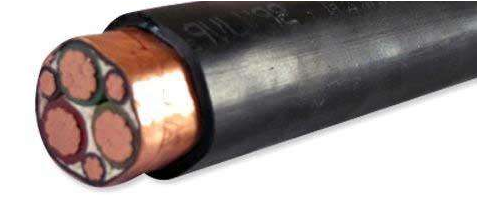Send Time:2019-3-11
Before you say how cheap the cable is, let's see if these tests work.
Source: Cable recruitment network
Never mind how cheap the cable is, let's see if these tests work.
1. Electrical performance test
The main conductor DC resistance, insulation resistance, finished product voltage test and insulation intercore voltage test are all very important. The conductor resistance directly reflects the electrical transmission performance of the cable. It directly affects the temperature, life, voltage drop, and safety of the cable during power operation. It mainly examines the material and cross-sectional area of the conductor. If the material of the conductor is not good or the cross-sectional area is seriously insufficient, the conductor's DC resistance will be seriously exceeded. Such cable laying in the line will increase the loss of current passing through the line, cause the cable conductor itself to heat up, cause the insulation aging cracking of the covered conductor, cause the power supply line to leak electricity, short circuit, and even cause fire, endangering the safety of people and property.. The standard has strict regulations on the conductor DC resistance value of different specifications cables, and it must not exceed the value specified in the standard.
Insulation resistance, finished voltage test and insulation intercore voltage test all examine the electrical insulation performance of cable insulation layer and sheath layer. Insulation resistance is to detect the resistance of insulation material between two conductors. It should be large enough to play Insulation protection. The voltage test of the finished product and the voltage test of the insulation wire core not only require sufficient insulation ability of the cable, but also require that the insulation or sheath material be evenly free of impurities and the thickness is uniform enough. The surface can not have invisible trachoma, needle holes, etc.. Otherwise, it will cause local breakdown during the pressure resistance test.

2. Mechanical performance testing
It mainly examines the tensile strength and fracture elongation of insulation and sheath plastic materials, including before and after aging, as well as the bending test, bending test, loading core test, insulation core tear test, and static bending test for finished soft cables. Before and after aging, tensile strength and fracture elongation before and after aging are the most important and basic indicators of cable insulation and sheath protection materials. They require that they be used as cable insulation and sheath materials. They must not only have enough tensile strength to be easily pulled off, but also have a certain flexibility..
Aging refers to the ability of insulation and sheath materials to maintain their original properties under high temperature conditions. Aging should not seriously affect the tensile strength and elongation of the materials. These will directly affect the service life of the cables. If the tensile strength and fracture elongation are not qualified, When carrying out cable construction and installation, it is very easy to break the protective cover or insulator, or the cable used in light and hot environments is easy to become brittle and fracture, resulting in exposed charged conductors and electric shock.
In addition, because the soft cable is not fixed, there are repeated dragging and bending during use. Therefore, for the soft cable standard, it is also stipulated that the dynamic bending test, bending test, load core test, insulation core tear test, and static bending test are added to the finished cable to ensure that the cable is in practical use. Meet the requirements. For example, the dynamic bending test mainly evaluates whether the twisted wire of the soft conductor breaks and reduces the transmission performance of the electricity, or cuts the insulation and reduces the insulation electrical performance when the soft cable is subjected to mechanical tensile and bending stresses. Insulation under stress is a test method that affects the electrical insulation performance of the cable whether it is deformed or cracked.

3. Performance test of insulating and protective materials
Including thermal weightlessness, thermal impact, high temperature pressure, low temperature bending, low temperature tensile, low temperature impact, flame retardant properties and so on. These are to examine the properties of insulating and protective plastic materials. For example, the thermal weightlessness test is to detect the degree of degradation and volatilisation of materials after 7 days of high-temperature aging at 80 °C; (b) Thermal impact detection of cracking of the insulated surface after special winding at 150 °C at a high temperature of 1 H; High temperature pressure is used to detect the degree of elasticity of insulating materials after high temperature re-cooling. All cryogenic tests generally refer to changes in mechanical properties at -15 °C, and all detect whether the cable material becomes brittle, cracking, or Yiladuan at low temperatures. In addition, the flame retardant performance of the cable is very important. The test to test this performance is a non-delayed flame test, that is, a special flame is ignited for a certain period of time for the standard installed finished cable, and the cable is inspected after the flame is extinguished. The situation, Of course, the smaller the burned part, the better, indicating that it is less flammable, better flame retardant, the safer.
4. Sign check
The standard requires that the cable package should be accompanied by a label or logo indicating the product type, specification, standard number, factory name and origin, and the specifications include rated voltage, core number, and conductor nominal cross section; The surface of the cable shall be printed with a continuous mark of the manufacturer's name, product type and rated voltage. The mark spacing shall be ≤ 200mm(insulating surface) or ≤ 500MM(protective surface). The marking content shall be complete, clear, and durable. This requirement is to facilitate users to understand the cable model specifications and voltage level to prevent errors in laying.
In addition, the wire insulation core should give priority to the standard recommended color, especially the yellow-green two-color core, which is generally used in the power cord of electrical products. This special two-color wire is used for grounding. For the yellow-green collocation standard, there are also the following regulations: For each two-color insulating core of Changqiao ~, one of the colors should cover at least 30 % of the surface of the insulating core and not more than 70 %. The other color covers the rest of the insulation core, that is, the yellow and green colors should be basically balanced.
5. Structure Size Detection
Including insulation and sheath thickness, thinnest thickness, shape dimensions, etc.. The thickness of insulation and protective covers plays an important role in how strong the cable can withstand the voltage, and its mechanical properties. Therefore, for different specifications of cables, the standards are strict on the thickness. The requirements shall not be lower than the prescribed values of the National standards. Too thin cable insulation thickness will seriously affect the safety of the use of cables, will bring cable breakdown, conductors exposed to cause leakage and other safety hazards, of course, is not as thick as possible, should not affect the installation, so the standard has set a size requirement for this limit.
Common Authentication Marks
1. CCC certification is mandatory certification and is a pass to enter the domestic market.
2. CB certification facilitates the export of products directly related to personal safety electrical products for use in households, offices, workshops and similar places. Such products are subject to compulsory certification in a certain country, that is, they are allowed to export to that country after obtaining the country's certified qualification. And sold on the market in the country. Even in countries that do not have mandatory certification, consumers are willing to purchase certified products with certification marks for their own safety.
3. CE certification
It is a pass for products to enter the European Union and the European Free Trade Zone country market. Products that are certified with a CE Mark will reduce the risk of being sold on the European market:
1) the risk of being detained and investigated by the customs;
2) Risks investigated and dealt with by market supervision agencies;
3) The risk of allegations by peers for competitive purposes.
4) UL Certification In the U.S. market, consumers and buyers are more willing to purchase products with UL certification marks.
欢迎咨询
我们会尽快联系您
